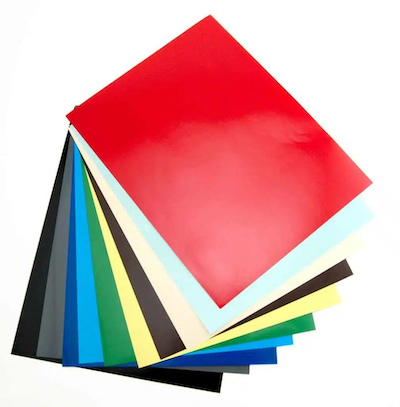Have you ever stopped to think about how much paper plays a role in our most important moments?
From love letters to diplomas, wedding invitations to birth certificates, a piece of paper documents life's milestones.
Although a newly married couple may give little thought to the type of paper their marriage certificate is printed on, for a business, it is crucial to know what kind of paper is needed to print/copy essential documents on.
Beyond paper size, material, and color, the specific type of printing paper you choose can make a difference in your output. Using the appropriate paper type can prevent paper jams, low-quality prints, and wasted money.
We've learned a lot about printer paper over nearly four decades in the printer/copier industry. Although we don’t sell paper, we want to share our knowledge. We aim to provide essential information about the various types of printer paper available. Additionally, we highlight the features you should consider when selecting the right paper for your needs.
After reading this article, you should have a solid understanding of the type of paper you need for your machine so you can make the most accurate printer paper purchase.
Choosing the right type of printer paper is essential, but size also matters. The wrong size can lead to printing errors, wasted materials, and frustration. Check out our guide to standard printer paper sizes to learn which sizes work best for different print jobs.
Printer Paper vs. Copy Paper
Printer paper is a type of paper specifically designed for use in printers and photocopiers. There are six common types of printer paper, which we will discuss in detail in the next section.
Many people are often confused about whether printer paper is the same as copy paper and can be used interchangeably. The short answer is yes; you can use either type to print documents containing text.
However, to get the best printing results, you should know some differences between printer paper and copy paper. These differences include the following:
- Standard copy paper has a weight commonly known as 20 lb. bond and is slightly thinner, while standard printer paper is referred to as 24+ lb. bond paper and is thicker.
- Copy paper tends to be cheaper than printer paper.
- Copy paper is typical for everyday printing, while printer paper offers a smoother surface that works better for higher-quality documents or those with images.
The 6 Different Types of Printer Paper
Now that you know the difference between printer paper and copy paper, let's go over the six different types of printing paper you need to be aware of:
Regular Matte Paper
Regular matte paper is the most common type used to print documents and will suit most basic print jobs.
You can consider this paper the traditional "copy paper" mentioned earlier. It has a smooth, matte texture that absorbs ink and dries quickly to avoid smudging and smearing.
Glossy Paper
This is the shiny stuff. Glossy paper has a coat of polymer that gives it a smooth shine and provides a richer color output that's more vibrant than regular paper.
This type of paper is ideal for printing high-quality photographs and vibrant images. However, it has a longer drying time than regular paper, so if not handled correctly, you might experience smudges. It's best to use a laser printer on glossy paper to avoid this.

Example of glossy paper, courtesy of Hygloss Products
Bright White Paper
While regular paper might seem white, bright white paper has specially formulated features that give it an exceptionally smooth surface and a brilliant white coating.
It is a type of high-quality paper with an elegant look, making it perfect for documents with photos requiring a vibrant finish without a glossy shine.
Photo Paper
As the name suggests, photo paper is designed primarily for printing photographs or pictures.
Do you recall the last time you held a photograph printed on photo paper? If so, you may remember that the front and back of the paper had very different textures and appearances. One side usually has a high-gloss sheen, while the other has a matte finish. Additionally, photo paper is typically thicker than most other types of paper.
Heavyweight Paper
The most common type of heavyweight paper is cardstock, which you may have heard of before since it's a common paper term among print consumers.
However, there are different weights of printing paper to choose from, determining its thickness. Think of paper weight as whether a sheet of paper is thin or thick.
Pro-Tip: When selecting heavyweight paper, ensure it is compatible with your copier/printer and use the recommended tray for that paperweight.
Inkjet Paper
The last type of printer paper is inkjet paper, designed for smaller desktop inkjet printers.
Inkjet printers use liquid ink instead of the dry powder-like toner laser printers use. Check out our blog post on the differences between inkjet and laser printers to learn more.
Common Paper Problems Businesses Face
Choosing the right type of printer paper is important, but many businesses don’t realize that paper-related issues can cause major inefficiencies in their printing environment. Even with high-quality paper, offices often experience:
- Frequent paper jams because of incompatible paper affect productivity
- High paper waste from unnecessary prints or incorrect settings
- Inconsistent print quality due to incorrect paper usage
- Rising printing costs from excessive toner and paper consumption
If your office struggles with these issues, the problem might not just be the paper—it could be the way your printing environment is managed. Find out how Managed Print Services (MPS) can help you optimize print usage and cut costs here.
3 Different Printer Paper Features
Now that you've seen the six different types of printer paper let's go over one more thing you need to know: its features.
While you can purchase printer paper in a variety of different colors and sizes, there are specific features that affect the quality of your output. Printer paper has three primary features: Coating, brightness, and weight. What do these three features mean as they relate to printer paper? Let's review them below:
Coating
The coating is the type of polymer, or synthetic substance, layered onto the paper to make it glossy and bright.
If you have ever noticed a shiny appearance on a piece of paper, it is likely due to its coating.
Brightness
Brightness refers to the degree of whiteness and brightness of a page. The brightness scale usually goes from 0-100, with 80-100 being the sweet spot for quality prints.
The general rule of thumb is that the brighter the paper, the better the quality and look of the overall print job.
Paper Weight
Paper weight refers to the thickness and weight of your printing paper. It’s not the weight of an individual sheet of paper; it’s typically determined by the weight of a ream of uncut paper (around 500 sheets).
This weight is measured in pounds (lbs) or grams per square meter (gsm), known as basis weight.
Different types of paper come in varying weights. The most common paper weight is regular paper weighing 75 grams or 20 lbs. (like the copy paper mentioned in the first section). Cardstock is the most frequently used "thick" paper, usually around 176 grams or 65 lbs.
Understanding why paper gets measured in grams or lbs. can be confusing, particularly when you encounter terms such as bond, cover paper, or GSM.
If you want to learn more about paper weight and how to choose the appropriate one for your project, the Paris Corporation's Paper Weight Guide is a great resource.
Printing Efficiency Goes Beyond Just Paper
Selecting the right printer paper is just one piece of the puzzle when it comes to print efficiency. Without proper management, businesses face excessive waste, supply shortages, and unnecessary costs.
That’s why many organizations turn to Managed Print Services (MPS) and Print Management Software to:
- Control print costs & reduce waste
- Automate supply replenishment & maintenance
- Improve security & compliance for sensitive documents
In addition to choosing the right paper, managing print volume and costs is key to running an efficient office. With print management software like Y Soft SafeQ, businesses can track print usage, reduce unnecessary prints, and optimize supply management.
Curious how these solutions can streamline your office printing? Check out the following blogs:
What Else Should You Learn About Your Printer?
Understanding printer paper types can help you avoid using the incorrect type, which can cause paper jams and waste money, leading to frustration and annoyance.
Trying out different options is a good idea when deciding on the correct type of paper to use. Start by buying the smallest sample size of the paper you're interested in and test it to see if you like the results. If you're unsatisfied, try a different kind of paper and keep looking until you find the one that works best for you.
However, even the best paper won’t prevent wasted prints, downtime, or inefficiencies on its own. A well-managed print environment is key to reducing costs and increasing productivity.
Struggling with wasted prints? A Managed Print Services (MPS) solution can help:
- Reduce printing costs & paper waste
- Optimize your office’s entire printing environment
Discover how our MPS solution can streamline your workflow and reduce office printing frustrations.
Take Control of Your Office Printing
Beyond knowing about paper types, true efficiency arises from overseeing your entire print operation. Whether your goal is to cut unnecessary costs with managed print services or to achieve advanced tracking and print usage optimization with Y Soft print management software, we’re here to help you make the right decision.
